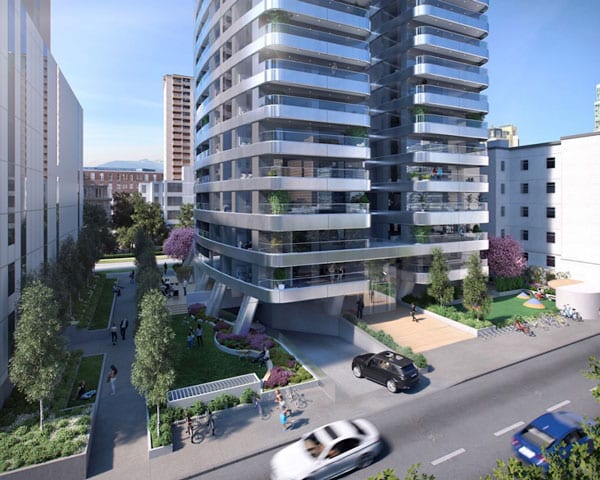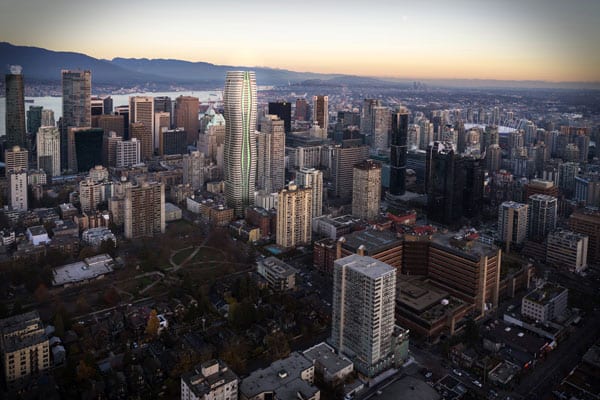Photo: Henson Developments
The City of Vancouver has given the green light to a 60-storey, landmark residential tower with 485 homes that will be the tallest Passive House building in the world.
The 480-unit build is slated for a parcel of land along Nelson near Thurlow Street in the west end of the city and will overlook the Stanley Park portion of the downtown peninsula.
Design of the building is unique in that it will be a slender-looking tower with a façade designed to resemble two vertical wavy bands with greenery in between. U.K.-based WKK Architects and IBI Group took their cue from the downtown peninsula with its forest between two coastal edges. Architect Tom Wright decided to rotate this image from horizontal to vertical.
A Model Tower
The idea is to have the building serve as a blueprint for similar towers in other cities around the globe.
Because it’s a Passive House, the tower will be required to meet strict international standards for energy efficiency focused on creating an airtight structure and sustainable solution standards.
Rick Gregory, executive vice-president of Henson Developments Ltd. in Vancouver, which is developing the property, said a lot more work goes into building a structure to Passive House standards.
“You’ve got tests in the field as you’re building to make sure that it’s being built in accordance with the drawings and it’s performing according to the specifications,” he said.
As such, the architects have paid careful attention to internal systems, cladding, windows and connections. Cladding on the tower will be energy-efficient and windows will be triple-glazed with the latest coatings.

Cutting Edge Features
Efforts are also being made to ensure the tower has the best Sound Transmission Class, or STC rating, of any building in Vancouver. STC rating is a measurement of how well a building attenuates airborne sound.
Upon completion, the building will stand 586 feet tall. All in, it will have 102 social housing units, 50 market rental units and 328 market condo units.
The building will have two large heat, recovery, ventilation units and a centralized system which is unique for a building of its size and has never been done before, according to Gregory. In the winter, such units transfer heat from stale air that’s on its way out of the building to the fresh, cold air that’s coming in.
The building will be a traditional reinforced concrete structure with embedded structural steel components and alternating metal and glass bands on the exterior. Post-tensioned slabs will be used in construction.

High Standards
Developers are expecting some construction challenges with the build as it is tight quarters and Vancouver is on glacial till. Shoring and anchors will have to be installed. Crews will have to dig down 11 storeys.
The lower level walls will be anchored into the surrounding neighbourhood and sprayed concrete will be used to shore up the walls.
While it may resemble a traditional residential tower in some ways, in many ways it is not. To meet the Passive House standard, the building can not exceed 15 kilowatt hours per square metre of energy consumption per year.
To meet the exacting standard, architects have incorporated efficiency features in their specifications. On the engineering side, they’re also installing mass dampers to ensure the building doesn’t sway too much. As part of the build, the developers are looking at installing elastomeric dampers in the elevator core.
The project was approved by Vancouver city council in June and the developer is now waiting for a development permit. Meantime, the developer is finalizing the design and legal agreements with the city.
Vancouver is moving towards a zero-emission target for new buildings. The goal is to get the majority of buildings at that level by 2025, with a final deadline of 2030.
Leave a Reply